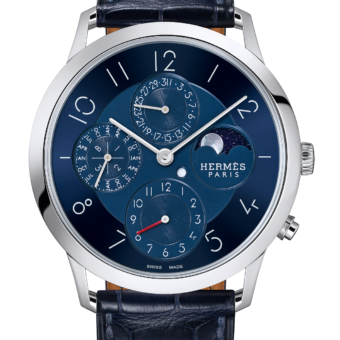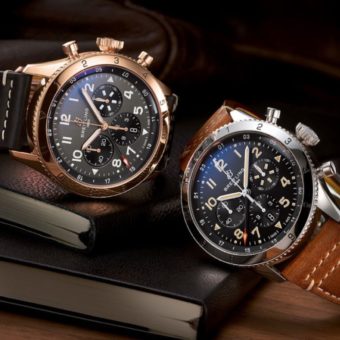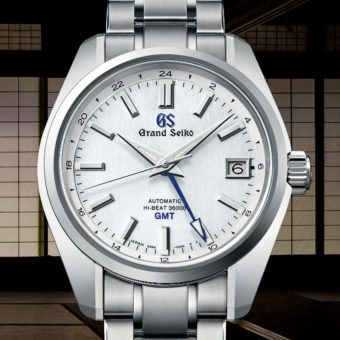We compared three elegant chronographs from Frederique Constant, Stowa, and Staudt. Visually, they all benefit from a symmetrical dial layout and lack of a date window, but are they more than just pretty faces? Find out in this review from our archives, with original photos by Olaf Köster.
Elegant chronographs belong to a very special category of watches that combine sportiness with a noble demeanor. Think of them as Riva speedboats for mere mortals. Chronographs are particularly handsome when their counters are positioned at 3 and 9, in a symmetrical arrangement called “bicompax.” If the chronographs also make do without a date display, as is the case with our three test watches, then they offer the best prerequisites for creating pure and convincing styling.
Frederique Constant: Classic Design
Frederique Constant takes the sportiest route of the three watches we tested with its Vintage Rally Healey Chronograph. This is an automotive-inspired watch with a perforated-leather racing strap made in collaboration with former sports car manufacturer Austin-Healey. The large numerals at 12 and 6 as well as the applied and luminous indexes create a dynamic effect. This is the only one of our trio of test watches that shows the time in the dark. And that is by no means the only interesting detail of this model’s dial. Bordeaux red distinguishes the minutes ring, the elapsed-seconds hand and the two small hands for the elapsed minutes, and the continually running seconds. The subdials and the ring for the elapsed seconds and fractions of a second are printed in dark gray, while light gray is used for all numerals and scales. Our other two candidates have taken a simpler approach.
The Vintage Rally’s beautifully crafted strap, which is a handsome gray-brown, has contrasting colored stitching in addition to neatly pierced holes. The buckle and its pin are stamped rather than milled. Both the buckle and the case are completely polished. The watch remains faithful to Frederique Constant’s characteristic style with its rounded shapes. The large knurled surfaces atop the mushroom-shaped push-pieces assure a good grip and reduce the amount of force needed to trigger them.
Sellita Caliber SW500, which Frederique Constant has modified to support the bicompax arrangement on the dial, can be seen through the sapphire back. Apart from the gilt rotor with Geneva waves, the movement remains wholly undecorated and even shows tiny scratch marks and traces left over from machining. With the exception of the fine adjustment lavished on it, Caliber SW500 is nearly identical to ETA’s Valjoux 7750.
With a loss of 0.5 seconds per day, the movement’s average deviation remained satisfyingly low. But the rate values varied too much among the different positions with a maximum loss of 6 seconds and a maximum gain of 6 seconds. Each Vintage Rally Healey Chronograph comes in a gift box that also contains a model of a racing version of the Austin-Healey 100 from 1953. The price of the Vintage Rally Healey Chronograph is reasonable ($2,795), but the absence of decoration on the movement is a bit disappointing.
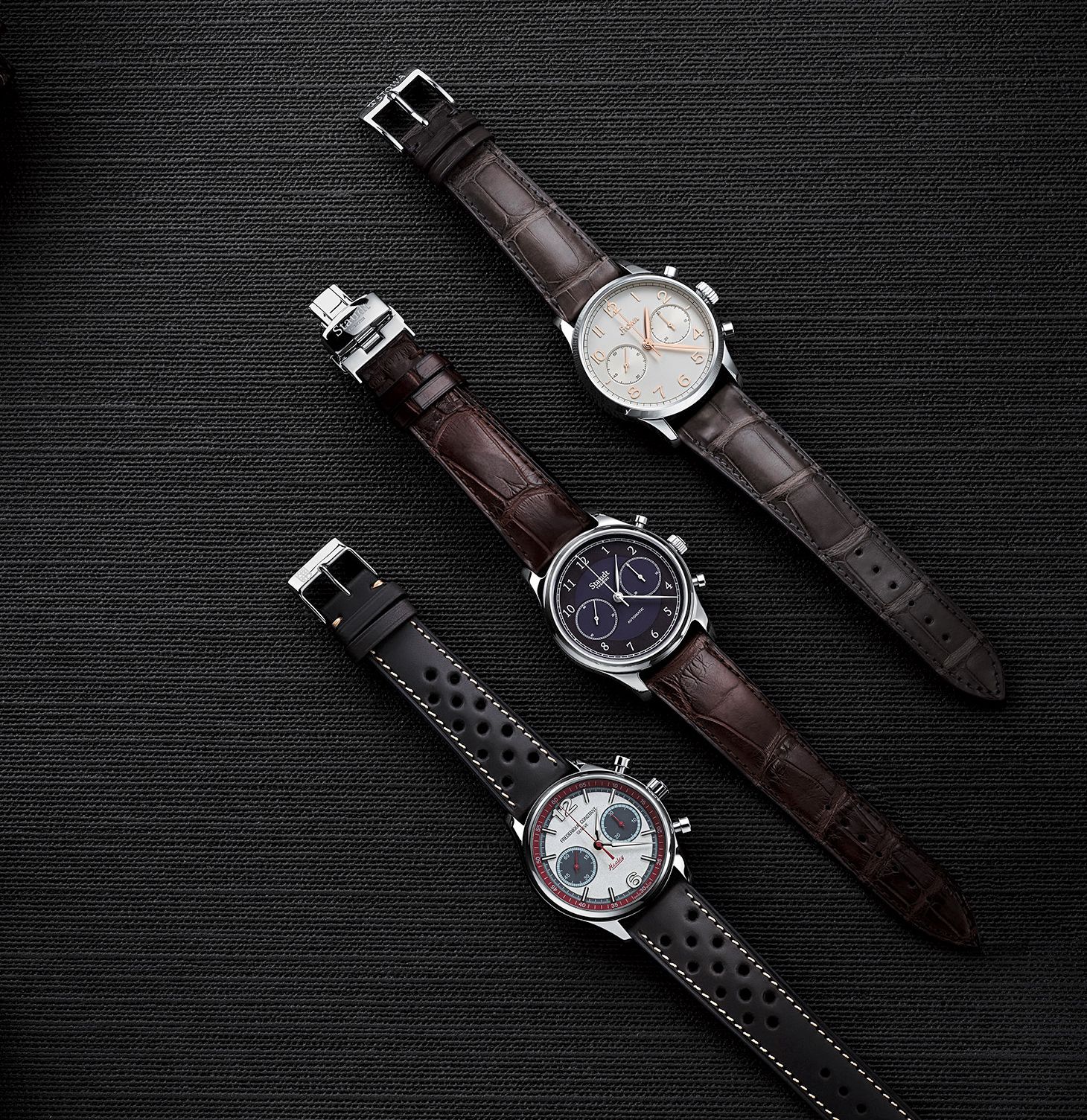
SPECS:
Manufacturer: Frederique Constant S.A., Chemin du Champs des Filles 32, CH-1228 Plan-les-Ouates, Switzerland
Reference number: FC-397HSG5B6
Functions: Hours, minutes, small seconds, chronograph with counter for 30 elapsed minutes
Movement: Modified self-winding Sellita Caliber SW500,“Elaboré,” 28,800 vph, 25 jewels, stop- seconds function, coulisse-lever switching, Incabloc shock absorption, fine adjustment via regulator and clamp, 46-hour power reserve, diameter = 30 mm, height = 7.9 mm
Case: Stainless-steel case with domed sapphire crystal, crown not screwed, fully threaded back with window of sapphire, water resistant to 50 m
Strap and clasp: Cowhide leather strap with stainless-steel pin buckle
Rate results (Deviation in seconds per 24 hours, fully wound/after 24 hours):
Dial up -3 / -1
Dial down +1 / +2
Crown up -5 / -5
Crown down +4 / +4
Crown left -6 / -5
Crown right +6 / +4
Greatest deviation 12 / 9
Average deviation -0.5 / -0.2
Average amplitude:
Flat positions 287° / 270°
Hanging positions 269° / 248°
Dimensions: Diameter = 42 mm, height = 13.6 mm, = weight 94 g
Limited edition of 2,888
Price: $2,795
SCORES:
Strap and clasp (max. 10 points): The perforated strap is tidily crafted, but its buckle is comparatively simple. 7
Operation (5): The nonslip push-pieces and the crown contribute to user-friendly operation. 4
Case (10): The fully polished case is well crafted. 7
Design (15): The racing design shows plenty of character with varied colors and large numerals. 11
Legibility (5): The contrast between the hands and the dial isn’t strong enough; luminous material enhances legibility in the dark. 4
Wearing comfort (10): The band is somewhat stiff, but otherwise the watch fits well around the wrist. 8
Movement (20): Frederique Constant modifies the “Elaboré” version of Sellita Caliber SW500, but unfortunately leaves the rotor undecorated. 11
Rate results (10): Low average deviation is praiseworthy, but a rather broad spread among the several positions is a drawback. 6
Value (15): The affordably low price demands a few compromises, but the overall cost-benefit ratio is good. 12
Total: 70 POINTS
Stowa: Retro style
Jörg Schauer’s Stowa brand from Germany’s Black Forest focuses primarily on pilots’ watches, but it also picks up other models from its long history. For example, the Chronograph 1938 Bronze, our test watch, borrows stylistic elements from a Stowa pocketwatch that debuted in 1938. In addition to the typeface used for the numerals, the galvanized bronze color of the hands and numerals also contributes to the watch’s retro look, which is further enhanced by the decision to forego a date window. The raised numerals are formed by eightfold embossing and the indentations for the subdials are milled. In all three of our test watches, the subdials do not extend to the edge of the main dial. However, the other two models more cleverly conceal this shortcoming, while the Stowa’s pair of stubby indexes at the 3 and the 9 add to the impression that the watch’s movement is too small for the case.
Speaking of the case, the Stowa’s meticulously fabricated housing is less successful than its competitors at concealing the constructive height that’s dictated by the watch’s thick caliber. Stowa polishes the entire case, but also offers some matte surfaces. The good workmanship continues in the crocodile-skin strap. Its buckle, however, is not perfectly polished on the inside and a magnifying glass reveals tiny furrows left from milling. The watch is comfortable to wear, although we found its strap somewhat stiff.
ETA’s Caliber Valjoux 7753 keeps time behind the transparent back. The rotor boasts a concentric pattern, circular graining, blued screws and gilt lettering for the Stowa name. Stowa is the only manufacturer in our trio to equip its watch with the higher-quality “Top” version of the movement. This chronograph showed impressive values on the timing machine, with an average daily deviation of +6.2 seconds and a maximum difference among the several positions of 7 seconds. Our test version of the Chronograph 1938 Bronze (with crocodile-skin strap) costs 1,706 euros, which makes it the least expensive of our three contestants.
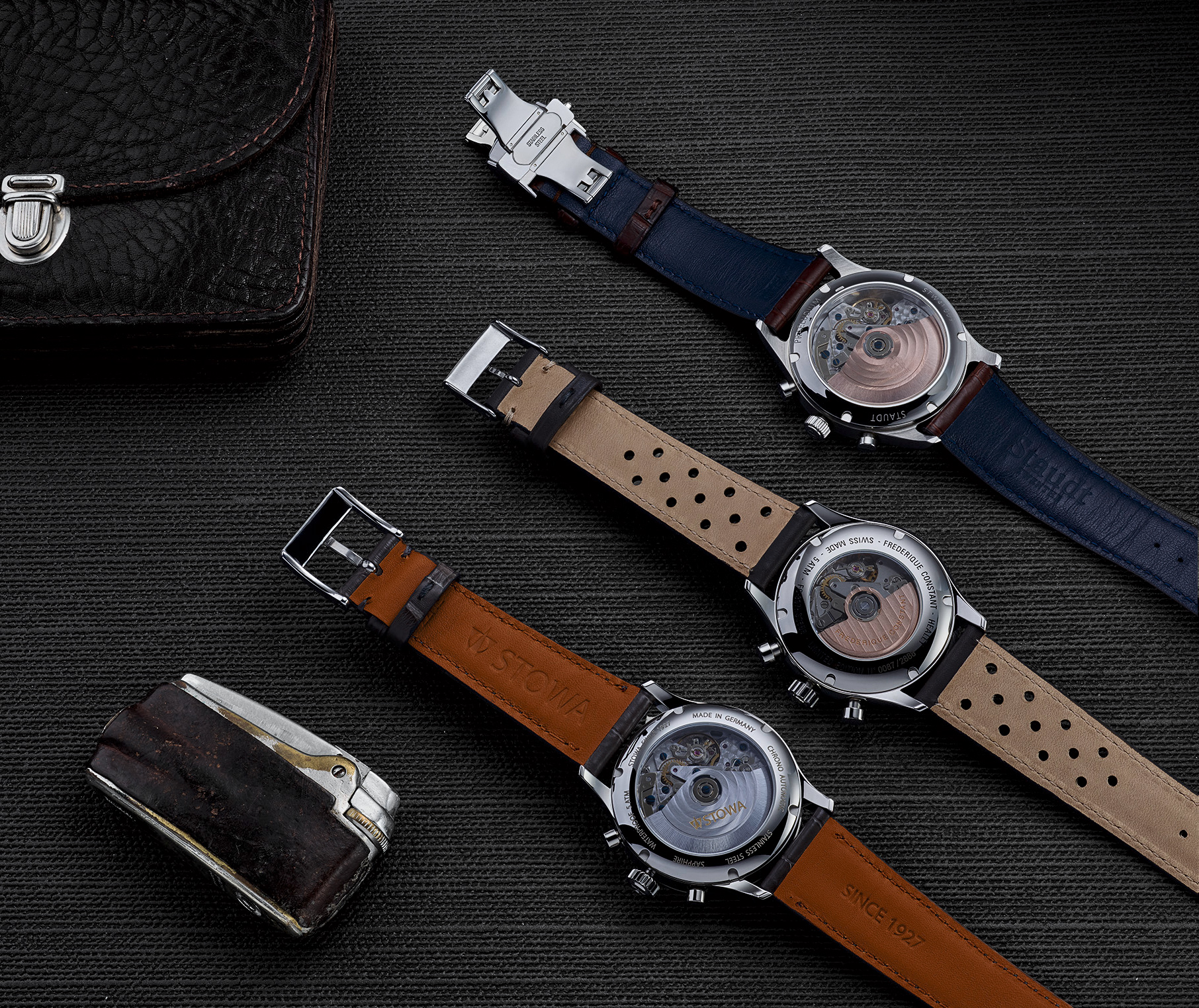
SPECS:
Manufacturer: Stowa GmbH & Co. KG, Gewerbepark 16, D-75331 Engelsbrand, Germany
Functions: Hours, minutes, small seconds, chronograph with counter for 30 elapsed minutes
Movement: ETA Valjoux Caliber 7753, “Top,” automatic, 28,800 vph, 27 jewels, stop-seconds function, coulisse-lever switching, Incabloc shock absorption, fine adjustment via regulator, 48-hour power reserve, diameter = 30 mm, height = 7.9 mm
Case: Stainless-steel case with domed sapphire crystal, crown not screwed, fully threaded back with window of sapphire, water resistant to 50 m
Strap and clasp: Crocodile leather strap with stainless-steel pin buckle
Rate results (Deviation in seconds per 24 hours, fully wound/after 24 hours):
Dial up +2 / +4
Dial down +7 / +7
Crown up +6 / +8
Crown down +8 / +8
Crown left +5 / +6
Crown right +9 / +10
Greatest deviation 7 / 6
Average deviation +6.2 / +7.2
Average amplitude:
Flat positions 273° / 262°
Hanging positions 247° / 233°
Dimensions: Diameter = 41 mm, height = 14.7 mm, weight = 102 g
Variations: With cowhide strap (€1,622)
Price: €1,706
SCORES:
Strap and clasp (max. 10 points): The crocodile-skin strap is handsome, but the pin buckle is not impeccably polished. 7
Operation (5): The push-pieces run smoothly and the crown offers a good grip. 4
Case (10): The fully polished case is somewhat thick. 7
Design (15): The watch has a distinctive and successful retro look; the subdials are quite close to the dial’s center. 12
Legibility (5): Good daytime legibility, thanks to strong contrast. 4
Wearing comfort (10): The strap is somewhat stiff at first, but otherwise this watch feels comfortable on the wrist. 8
Movement (20): The decorated ETA Valjoux Caliber 7753 comes in the higher quality “Top” version here. 13
Rate results (10): Stowa’s watch achieved good rate results. 7
Value (15): The least costly of our three candidates also has the best cost-benefit ratio. 13
Total: 75 POINTS
Staudt: Timeless elegance
The history of the Staudt brand began when the young Dutchman Yvo Staudt designed a watch for himself with a tidy blue dial. The model was so well received that he decided to start serial production in 2014. The chronograph was added in 2018. Our test watch, the Staudt Praeludium Chronograph, also has a dark blue dial. Certain parts of the dial with smoother surfaces have a darker appearance, such as the subdials and the inner portion of the dial. A rougher and darker colored surface accentuates the border of the subdials and the ring with the hour markers. These details, along with the minutes circle and the serif typeface used for the numerals, give the watch an elegant look. This look is furthered by the subdials, which only have the numerals 20, 40 and 60. The case is also elegantly designed. Its lofty height, which is dictated by the thickness of the movement, is hardly noticeable: the side has a flattening effect thanks to the satin-finished middle piece; the concave, polished bezel; and the base, which is polished and concave on the outside.
The dark brown alligator leather strap picks up the blue color of the dial on its underside. It fits very comfortably around the wrist. The double folding clasp with safety push buttons doesn’t rise too high and simplifies operation. It’s a standard component, decorated with the Staudt logo, but this detail didn’t bother us.
Here, too, a sapphire window offers a clear view of ETA Valjoux Caliber 7753. The decorations are on a par with Stowa’s embellishments: they include Geneva stripes, circular graining, blued screws and a gilded rotor. And the satisfying rate values, with a maximum difference of six seconds among the several positions and an average daily gain of +7.8 seconds, are also similar to those achieved by the other ETA Valjoux 7753. However, the amplitude declines significantly when the chronograph is switched on in the hanging positions.
At 2,471 euros, the Staudt Praeludium Chronograph is reasonably priced. It shows no major weaknesses, offers the case with the best workmanship and has a well-thought-out design. That’s why we named the newcomer Staudt the winner of our comparison, although admittedly all three chronographs can beautifully measure elapsed time.
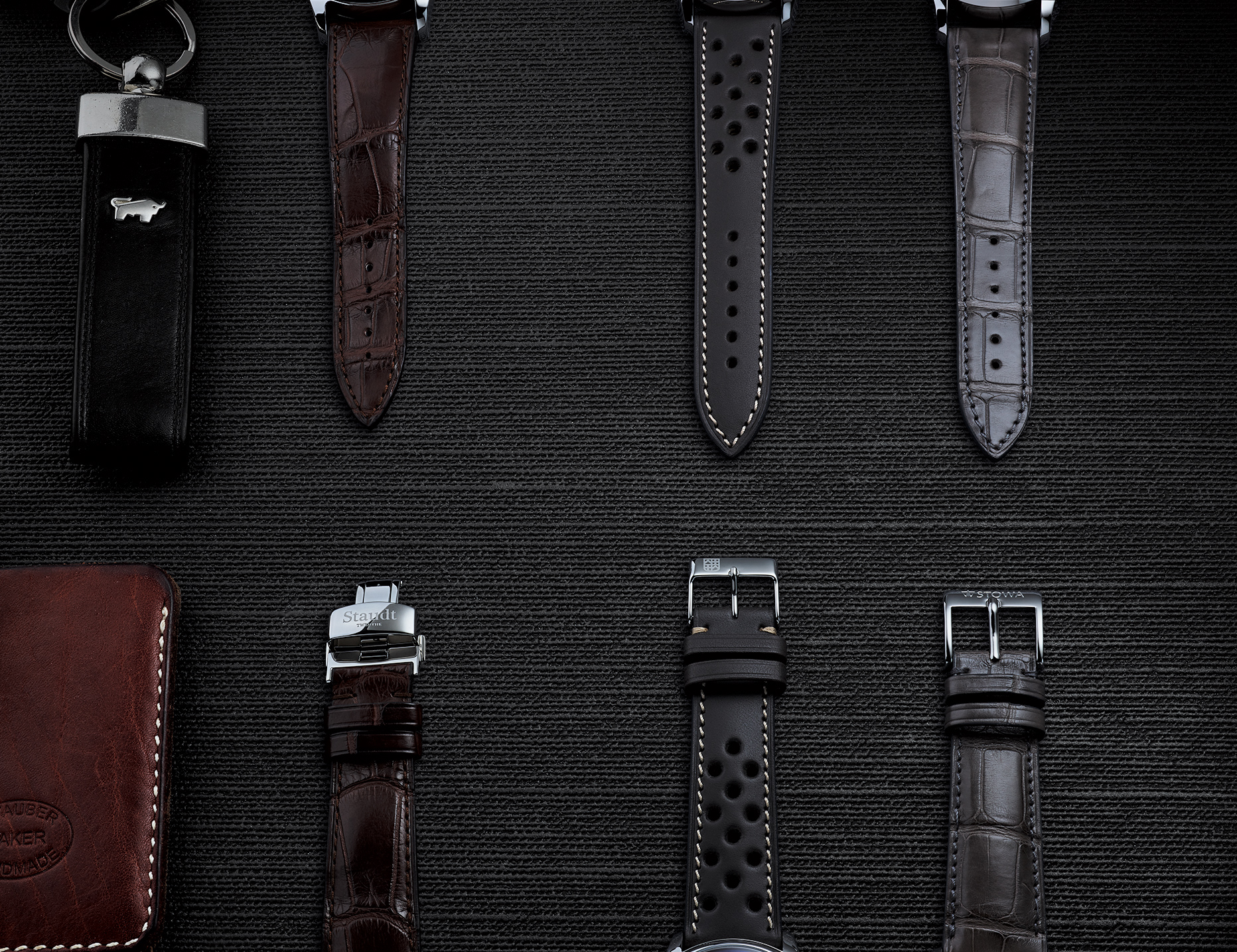
SPECS:
Manufacturer: Staudt Twenthe Watches, Boekelose Stoomblekerij 41, NL-7548 ED Boekelo, Holland
Reference number: P41.000
Functions: Hours, minutes, small seconds, chronograph with counter for 30 elapsed minutes
Movement: ETA Valjoux Caliber 7753, “Elaboré,” automatic, 28,800 vph, 27 jewels, stop-seconds function, coulisse-lever switching, Incabloc shock absorption, fine adjustment via regulator, 48-hour power reserve; diameter = 30 mm, height = 7.9 mm
Case: Stainless-steel case with domed anti-reflective sapphire crystal, crown not screwed, fully threaded back with window of sapphire, water resistant to 30 m
Strap and clasp: Alligator leather strap with secured folding clasp made of stainless steel
Rate results (deviation in seconds per 24 hours, fully wound/after 24 hours):
Dial up +5 / +7
Dial down +8 / +10
Crown up +10 / +6
Crown down +8 / +7
Crown left +11 / +8
Crown right +5 / +2
Greatest deviation 6 / 8
Average deviation +7.8 / +6.7
Average amplitude:
Flat positions 271° / 248°
Hanging positions 242° / 206°
Dimensions: Diameter = 41 mm, height = 13.6 mm, weight = 101 g
Price: €2,471
SCORES:
Strap and clasp (max. 10 points): The alligator leather strap and the double folding clasp with safety buttons are neatly crafted. 8
Operation (5): After the crown has been pulled out, the watch is easy to set. The push-pieces don’t require too much force. 4
Case (10): The alternately satin-finished and polished case with concave bezel is refined. 8
Design (15): The successful, pure, timelessly elegant design has many appealing details. 13
Legibility (5): The rhodium-plated hands contrast boldly against the dark blue dial, but the dial lacks luminous material. 4
Wearing comfort (10): The supple bracelet and the flat folding clasp enhance the wearing comfort. 9
Movement (20): Staudt decorates the simpler Elaboré version of the ETA Valjoux Caliber 7753. 12
Rate results (10): The average deviation and the greatest difference among the several positions are acceptable. 7
Value (15): This reasonably priced watch has the most to offer. 12
Total: 77 POINTS

